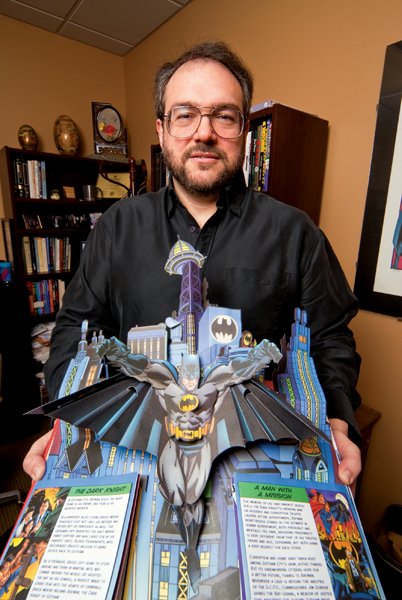ARKADELPHIA — What does Batman tell us about ourselves? Perhaps an even better question is, what do our thoughts about him and the fact that so many people think about Batman say about our society?
Travis Langley, Ph.D., a professor at Henderson State University in Arkadelphia, researches those questions and uses the words and deeds of superheroes to study how people interact and relate to others.
“I’m an experimental social psychologist,” he said. “I look for methods to study how people are affected by real or imaginary influences.”
Langley’s classes include the study of behavior when influenced by the media, such as literature, film and comic-book characters.
In one research project, members of Langley’s HSU class had people fill out questionnaires about how they felt about a “normal” person, a “perfect” person, and Batman. Langley said the results were surprising after the forms were returned from a group of prison inmates.
“The inmates seemed to have a more optimistic view of Batman than the college students we questioned,” he said. “The college students liked the dark side of Batman that we are seeing in the movies today. The inmates, who are criminals brought to justice, were more interested in Batman as a crime-fighter who they said was a cool, good guy,”
Langley also takes his research out of the classroom for presentations made at meetings, such as Comic Con International, a convention about all things related to comic books, along with science fiction and fantasy, film and television, animation, toys and video games in modern culture. The 2010 convention attracted 130,000 attendees.
At that convention, Langley has appeared with some Batman experts, such as Jerry Robinson, an artist who created the character The Joker; Michael Uslan, an originator of the current series of Batman movies; and Dr. Robin Rosenberg, a psychologist colleague who teaches on the psychological phenomena revealed by superheroes, including the course “Superheroes and the Life Lessons They Teach Us.”
Langley’s favorite co-panelist at conventions is Adam West, who played Batman on television in the 1960s.
“Adam brought Batman to life for me when I was a kid,” Langley said. “He is a good guy to talk to. He once asked me, ‘Dr. Travis, is Batman crazy?’ I told him he wasn’t.”
Like any self-respecting psychologist, Langley looks to his childhood to uncover his interest in comic books and, specifically, Batman.
Born in Arkadelphia, Langley often moved with his family after his father became a Methodist minister.
“We moved a lot, and it was hard to make friends all the time,” Langley said, “so I became fascinated with fictional characters.”
He said his mother used to read comic books to him while he looked at the pictures.
“I learned to read so I could read them myself,” Langley said. “I wanted to see why Neal Adams’ art was making Batman darker and more eerie. It wasn’t what I expected.”
Langley was an enthusiastic reader of comics into college, when the stories began to take strange twists as the publishers looked for ways to enliven the product, he said. Langley, as a fan, said that they failed.
“It became a waste of my brain,” he said.
Years later, his second son, Nicholas, began to show talent as an artist and was interesting in telling stories with his work, so Langley pointed him to comic books.
Several years ago, Nicholas was speaking at a Comic Con convention, and Langley wanted to go along. The psychologist made a poster presentation for the show, and it attracted attention, and his work and his interest in comics blended even more.
Now, Langley not only teaches classes in which an iconic character like Batman has his actions and motives analyzed, but Langley’s students also explore how the superheroes reflect the American mood as the crime-fighter and the nation change.
“Batman might be obsessive, but he was sane in the world where he lives,” Langley said. “It is different from ours, and it changes for different generations.”
He said Adam West’s Batman was the right character for the times.
“It was campy and a comedy,” Langley said. “West always played it straight, which made it funnier.”
The popular show of the Caped Crusader, in a world with Pop Art sets and comic graphics flashing words like “Pow” over live action, worked on two levels.
“Little kids loved the adventure and the heroes; the adults got the jokes and references,” Langley said. “I enjoyed it when my kids started seeing the jokes as they grew up.”
Later, in the recent “Dark Knight” movies, Batman has a very different costume, manner and even a different voice.
“In the first movies, Gotham, with its weird, Art Deco architecture, was nothing like the real world,” Langley said. “The movies with Christian Bale are in the same world we live in, and yes, Batman is crazy.”
Among the revelations Langley and his students found is that many characters, like Batman and Spiderman, fight for justice after a personal trauma.
Bruce Wayne sees his parents gunned down on the street and grows up to be Batman,” Langley said. “While Peter Parker already has his powers because of being bitten by a radioactive spider, he becomes a hero only after his apathy leads to the murder of his uncle Ben.”
Langley will speak on trauma and the superhero at a convention in San Francisco in March, as his work uses fantasy to help students better understand the complex emotions of living in the real world.
